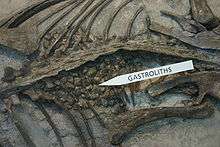Hühteeg Svita
| Hühteeg Svita Stratigraphic range: Early Cretaceous (?Berriasian - ?Barremian) | |
|---|---|
| Type | Geological formation |
| Sub-units | Öösh Formation, Ondai Sair Formation |
| Location | |
| Region | Dornogovi Province, Övörkhangai Province |
| Country | Mongolia |
The Hühteeg Svita (Mongolian: Хөхтээг формаци, Khökhteeg Formatsi) is a geological formation in Mongolia whose strata date back to the Early Cretaceous. Dinosaur remains are among the fossils that have been recovered from the formation.[1]
Vertebrate paleofauna
Dinosaurs
Color key
|
Notes Uncertain or tentative taxa are in small text; |
| Dinosaurs reported from the Hühteeg Svita | ||||||
|---|---|---|---|---|---|---|
| Genus | Species | Location | Stratigraphic position | Material | Notes | Images |
|
A. kurzanovi |
"Complete skull, partial skull, associated postcrania, several individuals."[2] |
Cast of the holotype skull of Altirhinus  Psittacosaurus fossil from the Hühteeg Svita with gastroliths in its stomach region, American Museum of Natural History | ||||
|
A. mongoliensis |
Teeth. |
Indeterminate Sauropod. |
||||
|
I. orientalis |
An indeterminate Iguanodont. A referred skull was reclassified as Altirhinus. |
|||||
|
P. mongoliensis |
Several teeth, fragmentary tibia, fragmentary fibula. |
Indeterminate Theropod. |
||||
|
P. mongoliensis |
Reclassified as a species of Psittacosaurus, Psittacosaurus protiguanodonensis. | |||||
|
P. mongoliensis |
||||||
|
P. protiguanodonensis |
Junior synonym of P. mongoliensis. | |||||
|
S. ashile[3] |
||||||
Mammals
| Mammals of the Hühteeg Svita | ||||||
|---|---|---|---|---|---|---|
| Genus | Species | Location | Stratigraphic position | Material | Notes | Images |
| Gobiconodon[4] | G. hopsoni[4] | Cannonball Member of Öösh Formation, possibly equivalent of Tevsh Formation. | Two upper and lower jaws (PSS-MAE 140 (Holotype) & PSS-MAE 139) |
Gobiconodon | ||
Pterosaurs
| Pterosaurs of the Hühteeg Svita | ||||||
|---|---|---|---|---|---|---|
| Genus | Species | Location | Stratigraphic position | Material | Notes | Images |
| Indeterminate Tapejaroid[5] | "Single Vertebra".[5] | |||||
See also
References
- ↑ Weishampel, David B; et al. (2004). "Dinosaur distribution (Early Cretaceous, Asia)." In: Weishampel, David B.; Dodson, Peter; and Osmólska, Halszka (eds.): The Dinosauria, 2nd, Berkeley: University of California Press. Pp. 563-570. ISBN 0-520-24209-2.
- ↑ "Table 19.1," in Weishampel, et al. (2004). Page 415.
- 1 2 Turner, A.S.; Hwang, S.H.; Norell, M.A. (2007). "A small derived theropod from Öösh, Early Cretaceous, Baykhangor Mongolia" (PDF). American Museum Novitates. 3557 (1): 1–27. doi:10.1206/0003-0082(2007)3557[1:ASDTFS]2.0.CO;2. Retrieved 2007-03-29.
- 1 2 Kielan-Jaworowska, Z., Dashzeveg, D. (1998). "Early Cretaceous amphilestid ("triconodont") mammals from Mongolia" (PDF). Acta Palaeontologica Polonica. 43 (3): 413–438.
- 1 2 Andres, B. and Norell, M.A. 2005. The first record of a pterosaur from the Early Cretaceous strata of Öösh (Övörkhangai; Mongolia). American Museum Novitates 3472: 1–6.
This article is issued from Wikipedia - version of the 7/3/2016. The text is available under the Creative Commons Attribution/Share Alike but additional terms may apply for the media files.